Wheelchair and mobility scooter ramps are essential tools to improve accessibility for individuals with mobility challenges. These ramps provide a safe and efficient way for wheelchair users and those using mobility scooters to navigate steps, doorways, and other obstacles. With a variety of materials such as aluminum and different designs ranging from portable to modular options, these ramps are designed to cater to diverse needs, ensuring smooth and secure movement across uneven surfaces.
Manufacturers offer a range of ramp styles, including portable, foldable, and threshold ramps. Portable ramps are lightweight and typically foldable, making them easy to transport and store. Threshold ramps are specifically designed to allow easier crossing over doorway thresholds and small steps. These products often come with features like slip-resistant surfaces and can be picked up in-store or ordered online from various home improvement and specialty mobility retailers. The selection process for a ramp typically involves considering the specific requirements of the user, the type of mobility device, and the environment in which the ramp will be used.
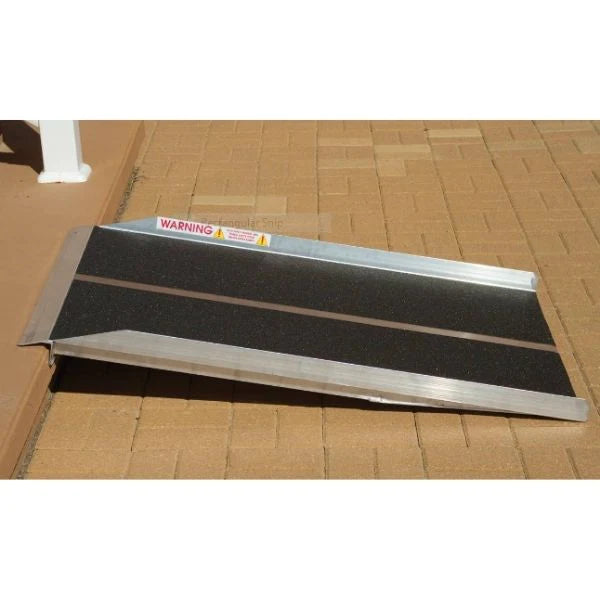
Understanding Wheelchair and Mobility Scooter Ramps
Ramps for wheelchairs and mobility scooters are essential for overcoming obstacles such as stairs and curbs, enabling access to buildings and vehicles. They vary in type, material, and length to meet different needs and comply with accessibility standards.
Types of Ramps for Wheelchairs and Scooters
Portable Ramps: Typically lightweight and foldable, making them easy to carry and store. Ideal for temporary access needs.
Threshold Ramps: Designed to smooth over the transition at a doorway or a single step, where the elevation difference is minimal.
Modular Ramps: Consist of multiple sections that can be assembled to fit specific locations. They are customizable and often used for permanent installations.
Vehicle Ramps: Specialized ramps that allow wheelchairs or scooters to enter and exit vehicles. They can be stowed inside the vehicle when not in use.
Importance of Ramp Length and Incline
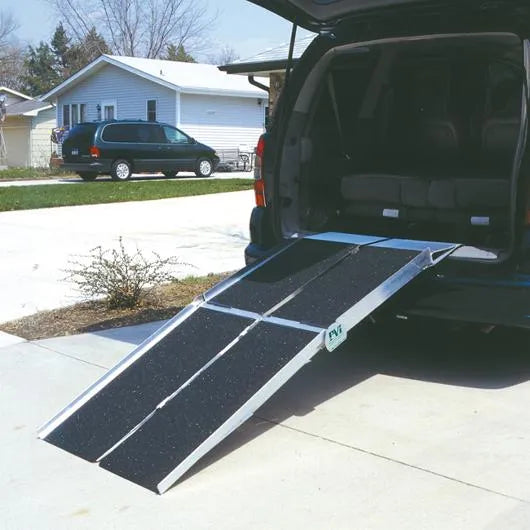
Optimal ramp length and incline are crucial for safety and usability. The recommended slope for wheelchair ramps is a 1:12 ratio, which means for every inch of vertical rise, there should be at least 12 inches of ramp length. For mobility scooters, adherence to the manufacturer's guidelines is necessary to ensure that the incline is not too steep for safe use.
Materials Used in Ramp Construction
Aluminum: Offers a balance between strength and weight, and is resistant to corrosion, making it suitable for outdoor use.
Steel: Provides high durability and load-bearing capacity but is heavier and may require maintenance to prevent rust.
Wood: Aesthetically pleasing and versatile for home installations but requires regular maintenance to ensure longevity.
Composite: Durable and low-maintenance materials that can resemble wood or concrete while providing excellent traction and stability.
Design Standards and Accessibility Guidelines
This section covers the essential standards and guidelines for designing wheelchair ramps, focusing on compliance with the ADA, determining the appropriate length, and incorporating safety features.
Compliance with Americans with Disabilities Act (ADA)
The ADA sets forth detailed requirements to ensure that ramps are accessible to individuals with mobility disabilities. Ramps must have a slope of no more than a 1:12 ratio, which translates to one inch of rise for every twelve inches of run. Cross slopes—the slope perpendicular to the direction of travel—should not exceed 2%. Ramps that have a rise greater than six inches or a horizontal projection longer than 72 inches must have handrails on both sides.
Determining Proper Wheelchair Ramp Length
To determine the proper length of a wheelchair ramp, one must consider the elevation to be overcome and the slope. In a situation requiring a rise of 24 inches, the ramp must extend 24 feet, meeting the maximum slope standards of 1:12. For residential use, a steeper slope of 2:12 may be acceptable, resulting in a 12-foot ramp for the same rise.
Safety Features and Handrails
Safety is paramount in ramp design. Surfaces must be firm, stable, and slip-resistant. Handrails are mandatory for ramps with a rise of more than six inches. They should sit between 34 and 38 inches above the ramp surface and extend at least 12 inches beyond the top and bottom of the ramp run. Edges must have curbs or barriers to prevent wheelchairs from slipping off.
Portable and Threshold Ramps
Portable ramps and threshold ramps are essential for improving accessibility in various settings. They are specialized to cater to the mobility needs for entrance and exit purposes.
Advantages of Portable Ramps
Portable wheelchair ramps offer significant benefits, chief among them being flexibility in use. They are typically lightweight and can easily be carried, making them an optimal choice for temporary setups or travel. Many portable ramps are designed with non-skid surfaces to ensure safety and durability, capable of supporting weights around 800 pounds. These ramps also often come with features like slip-resistant treads and side rails to prevent accidents.
Selecting the Right Size for Threshold Ramps
When choosing threshold ramps, size is paramount to ensure a safe and seamless transition over doorways. The width and height of a ramp should align with the doorway's dimensions and the height of the threshold. Common sizes range from 2 feet to longer ramps that support a higher threshold. It's crucial to measure the height from the ground to the threshold's top and the width of the doorway to determine the appropriate size of the ramp.
Considerations for Doorways and Entryways
Threshold ramps are particularly designed to ease the transition over door thresholds. For secure installation, check the threshold's height and the available space around doorways and entryways. A proper fit ensures that the ramp provides a stable and reliable surface for the wheelchair or mobility scooter to cross. Products from Prairie View Industries emphasize quality and are tailored for various types of thresholds to support seamless access.
Incorporating portable and threshold ramps not only improves mobility but also enhances independence for individuals using wheelchairs or mobility scooters. Selecting the right ramp involves careful consideration of size, portability, and the specific needs of doorways and entryways.
Ramps in Residential and Public Environments
Ramps play a pivotal role in enhancing mobility for wheelchair and scooter users. They facilitate access in both private homes and public settings, ensuring safe and independent movement.
Home Mobility Solutions
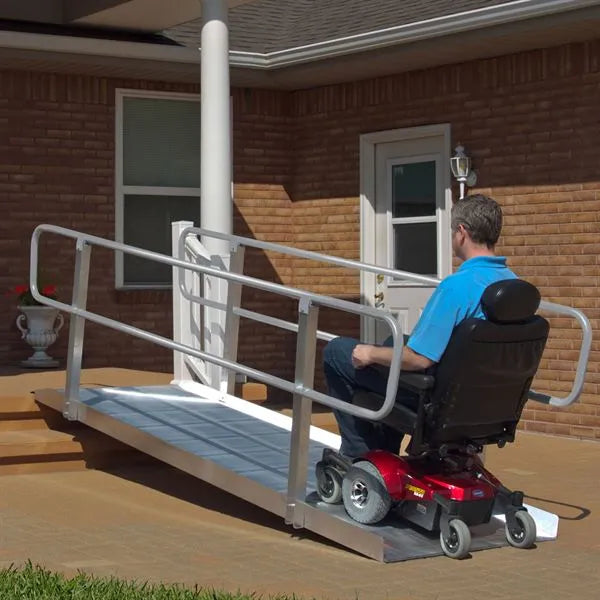
In residential spaces, home mobility is significantly improved through the installation of wheelchair ramps. These ramps allow for a smooth transition over steps or thresholds. For short-term needs, portable ramps present a versatile solution. Conversely, permanent ramp installations may be required for long-term accessibility. They must comply with specific guidelines and building codes to ensure optimum safety and usability.
Wheelchair Ramp Integration in Public Spaces
Public spaces are mandated by the Americans with Disabilities Act (ADA) to provide accessible facilities for individuals with disabilities. This includes the inclusion of properly designed wheelchair ramps in locations such as schools, hospitals, and government buildings. The design of these ramps follows strict ADA guidelines which dictate aspects such as the ramp's slope, width, and the need for handrails and landings to ensure they are safe and navigable for public use.
Usage of Ramps for Specific Scenarios
Wheelchair ramps play a vital role in enhancing mobility for wheelchair and scooter users, allowing them to navigate environmental barriers such as curbs, stairs, and inclines.
Navigating Curbs and Steps with Van Ramps
For users who travel by vehicle, van ramps provide an essential solution for entering and exiting their transport. A van ramp must be sturdy enough to handle the weight of the wheelchair or scooter and provide a gradual incline that can be easily navigated. The 1:12 slope ratio, where each inch of vertical rise requires at least 12 inches of ramp, is standard for safety.
-
Example: If a van floor is 24 inches high, a ramp of at least 24 feet in length would be required to achieve a safe incline.
Overcoming Stairs and Inclines
Stairs pose a significant challenge for individuals using mobility devices. Fixed or modular ramps cater to this need, often being installed at homes or businesses.
-
Criteria for Stairs Ramps:
-
Slope: Adheres to the 1:12 ratio for optimal safety.
-
Width: Sufficient for the device, typically exceeding 36 inches.
-
Surface: Non-slip, regardless of weather conditions.
Ramps for Caregivers and Assisted Mobility
When a caregiver is involved in assisting with mobility, portable or threshold ramps are extremely beneficial. They allow caregivers to help individuals overcome small environmental barriers like thresholds and single steps with ease.
-
Key Aspects:
-
Portability: Ramps that are foldable or lightweight for easy transportation.
-
Stability: They must remain secure during use to ensure the safety of both the caregiver and the individual.
Practical Considerations for Ramp Users
When considering ramp usage for wheelchairs and mobility scooters, users must account for the limitations and capabilities of their equipment, as well as their personal skills in handling and navigating different environments.
Handling Weight and Equipment
Wheelchairs and mobility scooters have varying weight capacities and dimensions that influence the choice of ramp. It is crucial to select a ramp that can safely accommodate the combined weight of the user and their equipment. For instance, power wheelchairs typically weigh between 50 to 250 pounds without the user, and a suitable ramp must support this weight plus the user's weight comfortably.
-
Checklist for Choosing a Proper Ramp:
- Total weight capacity.
- Ramp width to accommodate equipment size.
- Ramp's material and structural integrity.
- Portability if required for different locations.
Skills to Maneuver and Surmount Obstacles
The ability of a user to maneuver a wheelchair or mobility scooter and to surmount obstacles like thresholds and curbs is paramount for independent and safe mobility. Users should be confident in their skills to navigate inclines, tight turns, and other complex ramp scenarios. This may require practice or training, especially when using ramps that have steeper inclines or when maneuvering in confined spaces.
-
Key Skills for Ramp Users:
-
Maneuvering in reverse and turning sharp corners.
- Ascending and descending the ramp without deviating from a safe path.
- Recognizing and approaching different ramp materials and textures.
A user's proficiency in these areas directly impacts their ability to use ramps effectively and to maintain safety at all times.
Enhancing User Experience
When selecting and utilizing ramps for wheelchairs and mobility scooters, enhancing the user experience is crucial. This involves optimizing comfort and ease of use, as well as personalizing the ramps to meet individual needs and preferences.
Optimizing Ramps for Comfort and Ease
To maximize comfort, it is imperative that a ramp has a gentle rise that enables users to ascend and descend without excessive effort. Ramps with a slope that is too steep can pose challenges, particularly for manual wheelchair users or those with significant mobility issues. The recommended slope for a wheelchair ramp is a 1:12 ratio, meaning for every inch of vertical rise, there should be at least one foot of ramp run.
The surface of the ramp should be made of non-slip materials to ensure safety in various weather conditions, offering a stable transition between ground surfaces. Additionally, the width must accommodate the device, with additional space for users to maneuver comfortably, especially concerning any necessary turns on the ramp or at landings.
Personalizing Ramps to User Needs and Preferences
Tailoring a ramp to a user’s specific experience and mobility issues significantly enhances accessibility and independence. Personalization can include:
-
Adjustable features: Some ramps come with height adjustments to fit different entry points.
-
Portable vs. permanent: Portable ramps offer flexibility and are ideal for users who travel, while permanent solutions are more suitable for consistent daily routes.
Custom options such as handrails or edge barriers can provide users with additional security and confidence while navigating the ramp. Ensuring the ramp fits the individual's environment and lifestyle needs not only improves safety but also the overall user experience.
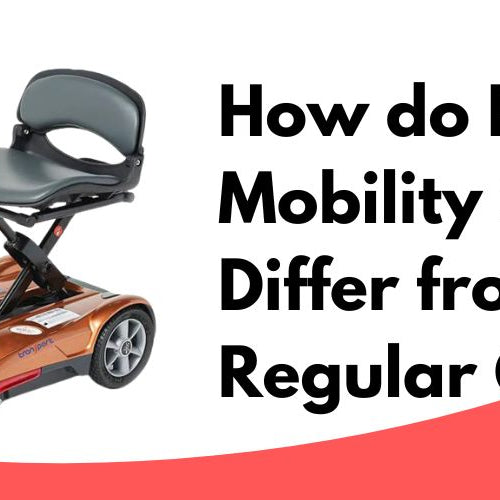







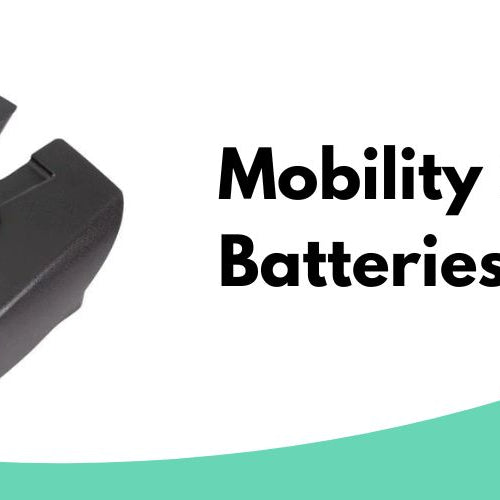
Leave a comment